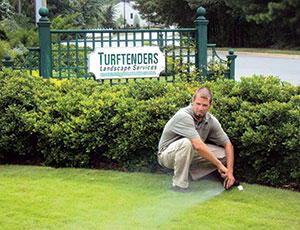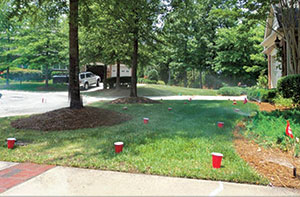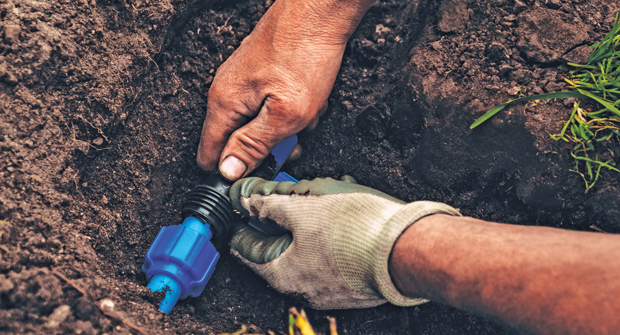Contractors can add value to their irrigation services by identifying cost-saving opportunities for clients.
Over the past century, advancements in irrigation technology have created more efficient and accurate systems. Still, many irrigation system users are unaware their systems are outdated or inefficient. For irrigation contractors, this presents an opportunity for upgrades, replacements and other maintenance needs.
The challenge is identifying these needs and then communicating them to customers. Irrigation audits can be an effective way to upsell customers on solutions for irrigation systems. Turftenders Landscape Services, based in Raleigh, N.C., began offering commercial customers irrigation audits more than two years ago as a money-saving service.

While the audits haven’t become a major revenue generator for Turftenders, the company views the offering as a potential market differentiator, says Chase Erwin, Turftenders’ business development manager.
“Our company tries to be a solutions provider,” Erwin says. “It’s very competitive in Raleigh, and there are a lot of companies that are great at landscape maintenance. They try to maintain what’s existing. For us, we try to take more of an outside-the-box approach.”
Being a solutions provider means helping customers find long-term savings in an environmentally friendly way through water conservation, Erwin says. Turftenders President Steve Hill created the irrigation auditing program after attending an annual water symposium in North Carolina about two years ago. One of the main conference topics was the subject of irrigation-related water conservation. The discussion touched on water scarcity in the region and the rising cost of water. Seeing an opportunity to help customers reduce costs and save water resources, Turftenders decided to offer irrigation auditing services, Erwin says.
Turftenders markets the irrigation audits primarily to homeowner associations, condominiums and other commercial clients rather than smaller residential properties. That’s because a property with few irrigation zones will likely find less value in an audit that can cost between $500 and $2,000, based on the number of zones, Erwin says. Turftenders charges separately for the audit and any additional work related to the audit findings.
How it works
Turftenders markets the program by mailing a cover letter explaining the audit portion of its irrigation efficiency program, which it calls Liquid Assets, to select customers. This year, the company plans to send the letter to approximately 200 commercial clients. Turftenders conducts the audit to map the irrigation system to pinpoint design flaws and identify leaks or broken heads.
The company begins the audit process by turning on every zone and then observing the system in operation to identify performance problems. The technicians look for obvious signs of malfunction, including sunken sprinkler heads, misaligned spray patterns (identified by brown spots in certain areas) and misting or fogging, which can be a sign of overpressure.
From there, Turftenders conducts performance testing to calculate the precipitation rate, so the company can determine uniformity of the application. The process helps Turftenders technicians know how long the system should operate. Measuring the precipitation rate is less sophisticated than it may sound. Turftenders conducts the process by placing red plastic cups along a mapped-out grid system in the landscape. After allowing the system to run for several minutes, a technician measures how much water was collected in the cups. Using this data, the company can determine how much water per hour each area is receiving, Erwin says.
Turftenders enters the data, including usage information from the client’s water bills, into a spreadsheet provided by Rain Bird. The spreadsheet calculates savings and the payback time frame. With the audit complete, Turftenders follows up with a report detailing a plan to potentially save water at the property. The letter includes estimates of potential gallons and money saved if the customer follows through with the suggested actions. Some of the recommendations may include retrofits, capping off certain heads or eliminating zones, as well as ensuring the controller is properly scheduled.

The results
One housing development already has realized significant savings from the program. The housing community encompasses 71 homes on 11.5 acres, including nearly 74,000 square feet of fescue turf. After the first full year in 2011, the Turftenders’ client realized a decline in landscape water consumption of 638,792 gallons from the previous year and a water cost savings of $5,950.
Turftenders installed new pressure-regulating heads to improve water distribution and eliminate misting. The company also cut the total number of heads from more than 1,000 to 880. Turftenders expects the client to recover its initial capital investment in three-and-a-half years and save more than $71,000 over the system’s lifespan.
So far, Turftenders has achieved some success with the audit program, including a client who agreed to a $20,000 retrofit. Typical projects in the current economic climate have been a few thousand dollars, Erwin says. He’s optimistic that as water prices continue to rise, more customers will recognize the value of irrigation audits.
“It’s something that differentiates us from our competition, and everybody wants to save some money, Erwin says. “It’s also good for the environment. Here in North Carolina water rates are going up, and these irrigation systems are too valuable to these properties to just abandon them.”

